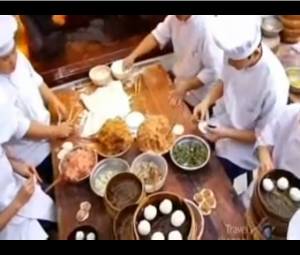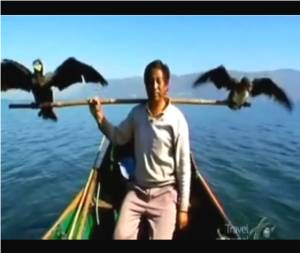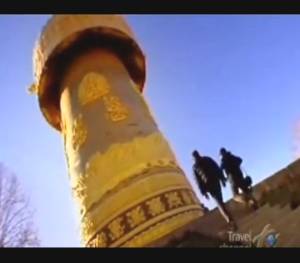Anthony Bourdain has a fondness for traveling to China. He's back, and this time he is going a little farther, a little deeper. Starting in Shanghai, an exploding economic superpower–where buildings go up as old ones go under, where the history gives way to what appears to be an inevitable future–as capital of the world. From Shanghai to Tibet, Anthony searches for the mythical Shangri-La.
Introduction:
Shanghai
Shanghai is located in eastern China, at the middle portion of the Chinese coast, and sits at the mouth of the Yangtze River. Because of Shanghai's status as the cultural and economic centre of East Asia for the first half of the twentieth century, it is popularly seen as the birthplace of everything considered modern in China.
Due to its rapid growth in the last two decades, it has again become one of the world's leading cities, exerting influence over finance, commerce, fashion, and culture. Shanghai is now aiming to be a global finance hub and international shipping centre in the future, and is predicted to become one of the world's main global financial centres, on the level of even London and New York in this regard.
Shanghai is the most populous city in China, with an estimated population of 23 million; 98.8% of Shanghai's residents are of the Han Chinese ethnicity, while 1.2% belong to various minority groups. An estimated 700,000 people from Taiwan live within the municipality, and the South Korean communities have more than 70,000 residents. Most Shanghai residents are the descendants of immigrants from the two adjacent provinces of Jiangsu and Zhejiang who moved to Shanghai in the late nineteenth and early twentieth century, regions that generally speak Wu Chinese. The vernacular language is Shanghainese, a dialect of Wu Chinese, while the official language nationwide is Mandarin.
Shanghai is also a popular tourist destination renowned for its historical landmarks such as The Bund, People's Square (the former racing track) and Yuyuan Garden, and its extensive yet growing Pudong skyline. It hosted the World Expo in 2010, attracting 73 million visitors. Shanghai is described as the "showpiece" of the booming economy of China. Although often viewed as a modern metropolis, Shanghai still contains some picturesque rural suburban areas.
Shanghai does not have a definitive cuisine of its own, but modifies those of the surrounding provinces (mostly from adjacent Jiangsu and Zhejiang coastal provinces). What can be called Shanghai cuisine is epitomized by the use of alcohol. Fish, eel, crab, and chicken are "drunken" with spirits and are briskly cooked/steamed or served raw. Salt-cured meats and preserved vegetables are also commonly used to supplement the dish.
Yunnan
Yunnan is a province of the People's Republic of China, located in the far southwest of the country. The capital of the province is Kunming.
Yunnan became part of the Han Dynasty (206 BC-220 AD) during 2nd century BC. It became the seat of a Tibeto-Burman speaking kingdom known as Kingdom of Nanzhao in the 8th century AD. Nanzhao was multi-ethnic, but the elite most likely spoke a northern dialect of Yi, which became established as the prestige dialect. The Mongols conquered the region in the 13th century, with local control exercised by warlords until the 1930s. As with other parts of China's southwest, Japanese occupation in the north during World War II forced a migration of majority Han people into the region.
Yunnan is rich in natural resources and has the largest diversity of plant life in China. Of the approximately 30,000 species of higher plants in China, Yunnan has perhaps 17,000 or more. Yunnan's reserves of aluminium, lead, zinc and tin are the largest in China, and there are also major reserves of copper and nickel. Yunnan has over 600 rivers and lakes, which provide an annual water supply of 222 billion cubic meters.
Yunnan is the home of three UNESCO World Heritage sites: the Old Town of Lijiang, the Three Parallel Rivers of Yunnan Protected Areas, and the South China Karst.
With a population of nearly 46 million people, Yunnan is noted for its very high level of ethnic diversity. It has the second highest number of ethnic groups among the provinces and autonomous regions in China, after Xinjiang (which has forty-seven ethnic groups). Among the country's fifty-six recognized ethnic groups, twenty-five are found in Yunnan. Ethnic minorities in Yunnan account for about 34% of its total population. Major ethnic groups include Yi, Bai, Hani, Zhuang, Dai and Miao.
The Bai people who have lived and fish along the shores of Erhai Lake, near the city of Dali for nearly 3,000 years. Erhai Lake, is an alpine fault lake, and the second largest highland lake in China. It is an important food source for the Bai people, famous for their cormorant fishing.
Lijiang
Lijiang is an ancient city with a history going back more than 800 years. Lijiang is located in the foothills of the Himalayas in the northwestern part of Yunnan Province, and it borders Sichuan, China. It is in a region where the Qinghai-Tibet Plateau and Yunnan-Guizhou Plateau converge. Lijiang was once a confluence for trade along the old tea horse road.
Once a remote backpacker getaway, Lijang now attracts some more than 5 million tourists a year. The world famous Old Town of Lijiang is renowned for its orderly system of waterways and bridges, and is an UNESCO Heritage Site. Lijiang has a population of 1.1 million; the Nakhi are the predominant ethnic group.
The Nakhi are believed to be the descendants of the nomadic Qiang, an ethnic group inhabiting the Tibetan plateau since ancient times. After being pushed south by other conquering tribes, the Nakhi finally settled in Baisha and Lijiang by 3 CE. The Nakhi split into three groups while their ancestors were still in Baisha. The ones who remained are known as the Nakhi, those in Dali are known as Bai, and those living around the Lugu Lake are called the Mosuo. Even today, the three groups share similar customs.
The Nakhi are traditionally followers of the Dongba religion, rooted in the beliefs of the Tibetan Bön religion. The Dongba script is a pictographic writing system used primarily by the priests. The Dongba script appears to be an independent ancient writing system perhaps a thousand years old. After the 1949 Communist Revolution in China, the use of Dongba was discouraged. In 1957, the Chinese government implemented a Latin-based phonographic writing system for Nakhi. Then during the Cultural Revolution, thousands of manuscripts were destroyed. About half of the dongba manuscripts that survive today had been taken from China to the United States, Germany and Spain. Today Dongba is nearly extinct, and the Chinese government is trying to revive it in an attempt to preserve Nakhi culture.
Shangri-La County
Shangri-La County was formerly known as Zhongdian County. It was renamed in 2001 after the fictional land of Shangri-La in the 1933 James Hilton novel Lost Horizon, in an effort to promote tourism in the area. And like the fictional Shangri-La, the ambiance of the town is distinctly Tibetan with prayer flags fluttering, mountains known by holy names, and rocks inscribed in Tibetan language with Buddhist sutras.
Shangri-La County is located on the famous Southern Silk Road, which originates in Sichuan province in the north, crosses Yunnan province and goes to Vietnam. To this day, many travelers use the county town as a gateway into Tibet, either travelling many days overland by jeep to Lhasa, or by flying from the city's airport. However, the town itself is a tourist destination, primarily due to the nearby Gandan Sumtseling Monastery and the largest prayer wheel in the world, Pudacuo National Park, and Tiger Leaping Gorge.
Built in 1679, the monastery is the largest Tibetan Buddhist monastery in Yunnan province, and is sometimes referred to as the Little Potala Palace. It is also the most important monastery in southwest China. The monastery belongs to the Yellow Hat sect of Tibetan Buddhism of the Gelukpa order of the Dalai Lama.
Situated 3.1 miles from the town at an elevation of 11,090 feet, its architecture is a fusion of the Tibetan and Han Chinese. It was extensively damaged in the Cultural Revolution, when in 1959, the People's Liberation Army (PLA) of China bombed the monastery during their invasion of Tibet. It was subsequently rebuilt in 1983. At its peak, the monastery contained accommodation for 2,000 monks; it currently accommodates 700 monks.
Episode Recap:
Anthony begins his culinary quest for the mythical Shangra-La in Shanghai.
 NanXiang Steamed Bun Restaurant: Anthony meets a local friend Vicki at NanXiang Steamed Bun Restaurant, which is arguably the best place in Shanghai to eat soup dumplings. The restaurant is located in the City of God Temple precinct in the old Chinese section of the city. Anthony also tries the mighty tang bao, a large, soup-filled baozi (soup dumpling) from which the liquid is first directly drunk with a straw, and the flour skin eaten afterwards.
NanXiang Steamed Bun Restaurant: Anthony meets a local friend Vicki at NanXiang Steamed Bun Restaurant, which is arguably the best place in Shanghai to eat soup dumplings. The restaurant is located in the City of God Temple precinct in the old Chinese section of the city. Anthony also tries the mighty tang bao, a large, soup-filled baozi (soup dumpling) from which the liquid is first directly drunk with a straw, and the flour skin eaten afterwards.
Soup dumplings, a type of steamed bun that is filled with pork (most commonly found) or minced crab, and soup. Although it appears delicate, a soup dumpling is able to hold in the soup until it is bitten. They're steamed in bamboo baskets and served with black vinegar and shredded fresh ginger.
Wujiang Road: Anthony hits the streets in search of the best night-time street food in Shanghai. His guide Ming takes him to Wujiang Road, a short, twisty alleyway packed with fiercely competitive small restaurants and food stalls. Very cheap, but very Chinese, and famous for its night market and street food. Anthony samples the stinky tofu from a food stall, but he's not impressed.
Yang's Fry Dumplings Restauarnt: Anthony ducks into Yang's Fry Dumplings restaurant to try some fried dumplings.
Street Food: Back on the street, Anthony tries some spicy Szechuan-style noodles with beef.
Yangcheng Lake: Anthony heads to Yangcheng Lake, located one-hour outside of Shanghai. Yangcheng Lake is famous for it's Shanghai hairy crab, and Anthony wants to discover what's so special about the Shanghai hairy crab that it will sell for as much as $40. These fresh water crabs are a delicacy in Shanghai cuisine and are prized for the female crabs' roe. The ones grown in this particular lake are so highly priced because of the water quality is better. This is great for tourism, and droves of buses filled with the rising Chinese middle-class arrive to feast on the crabs. Anthony treats his tour guide and crew to a round of crabs.
 Cormorant Fishing: Anthony stops in Yunnan where he visits the Bai people who live and fish along the shores of Erhai Lake. He goes cormorant fishing.
Cormorant Fishing: Anthony stops in Yunnan where he visits the Bai people who live and fish along the shores of Erhai Lake. He goes cormorant fishing.
Cormorant fishing is a traditional fishing method in which fishermen use trained cormorants to fish in lakes and rivers. Historically, cormorant fishing has taken place in Japan and China from around 960 AD. and recorded from other places throughout the world. To control the birds, the fishermen tie a snare near the base of the bird's throat. This prevents the birds from swallowing larger fish, which are held in their throat, but the birds can swallow smaller fish. When a cormorant has caught a fish in its throat, the fisherman brings the bird back to the boat and has the bird spit the fish up. Though cormorant fishing once was a successful industry, its primary use today is to serve the tourism industry.
Wase Market: It's market day, so Anthony goes in search of some Bai cuisine at the Wase Market, near Dali City. Wase is a traditional and conservative Bai town with a weekly market aimed at both townpeople and nearby farmers. Anthony discovers a remarkable dish at one of the vendors: a fresh rice noodles, with soybean leaves, a chicken broth with soysauce, topped with scallions, pickled vegetables, sesame oil, and a chile pepper and meat sauce.
Home-cooked Bai Dinner: Anthony's guide Michael invites him to his home for a dinner. They start with raw pork, as an appetizer; a popular Bai dish that even Marco Polo enjoyed when he passed through the region. Then on to an impressive assortment of local dishes, including deep-fried pork nuggets; steamed pork in a rice-flour batter with potatoes; a sweet, slow-cooked barbecue-style pork; mushrooms with cured salt pork; live-cooked fish from lake Erhai with spicy-hot chilli pepper sauce; and the local moldy version of stinky tofu. The Bai prefer sharp, cold and spicy flavor, so they prefer cured ham or fish eaten with rice or flour.
 Hunting with Falcons: Anthony visits the city of Lijang, where the Nakhi are the predominant ethnic group. Nakhi men have a long, proud tradition of falconry, hunting with falcons. Anthony joins a local falconer and on hunt to learn more this ancient sport. He discovers that by tradition, although falcons live thirty years, their trainers set them free after 10 years of faithful service.
Hunting with Falcons: Anthony visits the city of Lijang, where the Nakhi are the predominant ethnic group. Nakhi men have a long, proud tradition of falconry, hunting with falcons. Anthony joins a local falconer and on hunt to learn more this ancient sport. He discovers that by tradition, although falcons live thirty years, their trainers set them free after 10 years of faithful service.
Lunch at a Monastery: Anthony visits a local monastery for lunch with his guide Yumei. He's somewhat skeptical since the monks are strict vegetarians, but decides to keep an open mind since the restaurant is quite popular with the locals. The main ingredient is a bean jelly called liangfen, which is a favorite staple of the Nakhi. It can be eaten cold or fried, but is customarily used in a number of traditional Nakhi dishes, each derivng their unique flavor from additions and toppings, the most interesting of which is the oil from the Szechuan pepper (fagara oil).
Jade Dragon Snow Mountain: Anthony rides a cable car 18,000 feet up to the highest peak, Shanzidou, atop Jade Dragon Snow Mountain for a view of its surrounding glacier. Jade Dragon Snow Mountain is a mountain massif (also identified as a small mountain range) near Lijiang, in Yunnan. Since Anthony neglected to bring along a tank of oxygen, he soon begins to rant, suggesting he may be experiencing symptoms of altitude sickness.
Gandan Sumtseling Monastery: Anthony finally finds himself in Shangri-La; well, at least Shangri-La County. After touring the town, he visits the Gandan Sumtseling Monastery. Built in 1679, Gandan Sumtseling Monastery is the largest Tibetan Buddhist monastery in Yunnan province, and the residence of 700 Buddhist monks. Anthony discovers that the monks are in the middle of a week chanting.
 Prayer Wheel: Anthony visits the world's largest prayer wheel. As Anthony stands before the prayer wheel, so large it takes several people to turn it, he realizes his history with livestock raises the possibility of him reincarnating as his favorite snack (a pig), so he decides to play it safe and help spin the wheel a few times for good karma.
Prayer Wheel: Anthony visits the world's largest prayer wheel. As Anthony stands before the prayer wheel, so large it takes several people to turn it, he realizes his history with livestock raises the possibility of him reincarnating as his favorite snack (a pig), so he decides to play it safe and help spin the wheel a few times for good karma.
Prayer wheels are used to accumulate wisdom and merit (good karma) and to purify negativities (bad karma). Prayers are inscribed both on the outside of the prayer wheel itself and the scroll(s) contained inside. According to the Tibetan Buddhist tradition, each revolution is as meritorious as reading the inscription aloud as many times as it is written on the scroll contain inside it; the more prayers that are inside a prayer wheel, the more powerful it is.
Home-cooked Tibetan Meal: Anthony visits with some Tibetan yak herders. He gets a tour of a typical Tibetan home—a fascinating mix of the practical and the spiritual. He's then treated to a traditional Tibetan meal of yak meat, cheese, a type of steamed buns (dumpling soup), yak cheese and yak butter tea. Unaccustomed to foreigners visiting their neighborhood, curious friendly neighbors join them for some yak butter tea.
Having finally reached the end of his quest to find Shangri-La, Anthony concludes that in the end it doesn't really matter whether it's real or mythical; it's really more about the experience of the journey.
Episodes:
 |
ARGENTINA: From the Tango to paragliding to cattle rustling to trekking along icy glaciers, Anthony experiences it all. |
 |
AUSTRALIA: Melbourne has been described as San Francisco without the fog. Anthony is off to discover what makes it so special. |
 |
BERLIN: Anthony finds himself in Berlin, a city that is for him both good and evil, Eastern and Western, repulsive and appealing. |
 |
BRAZIL: Some say São Paulo feels like LA threw up on NYC. But Anthony's back for the great food and its welcoming people. |
 |
CALCUTTA & BOMBAY: Anthony revisits his love for India's vibrant culture, cuisine & communities with a trip to Kolkata & Mumbai. |
 |
COLOMBIA: A bright and beautiful country that has gone from drug capital to food capital. Anthony explores its unique cuisine. |
 |
EGYPT: Anthony skips the long lines and tour buses, and visits with Egyptian locals to get a taste for what it means to be Egyptian. |
 |
GHANA: Anthony heads to Ghana, West Africa, a land of old forts and slave castles, and a culture filled with great food and music. |
 |
GREEK ISLES: Anthony is on a culinary odyssey to discover if Greece really does have the world's healthiest diet. |
 |
HONG KONG: A wonder-land of colors, lights and speed, a perfect marriage of modern and traditional, and home to great Asian cuisine. |
 |
IRELAND: Ireland's steeped in history and traditions, both oral & written. Anthony dispels the myths that it has the worst food on the planet. |
 |
JAMAICA: Jamaica is a vibrant, colorful land full of resorts and reggae music. Anthony is there to uncover the lesser-known Jamaica. |
 |
KOREA: Anthony gives in to his employee's pressure to visit Korea and, next thing you know, they're in Seoul and the adventure begins. |
 |
MEXICO: Carlos, a head chef in NYC and good friend, gives Anthony a culinary tour of his hometown Puebla and nearby Mexico City. |
 |
OSAKA (Japan): Anthony learns all about kuidaore, which means to bankrupt oneself with extravagance in food and drink! |
 |
PARIS: In this very first episode of the series, Anthony heads to the "City of Light" to show, at least the Americans, why the French don't suck. |
 |
PERU: Anthony is on a mission to obtain personal enlightenment in a land of ancient culture, rich cuisine, and vibrant people. |
 |
QUEBEC (Canada): Anthony is off to Québec to indulge in one of his most hedonistic pleasures–foie gras (fatty duck liver). |
 |
RAJASTHAN (India): From gorgeous sights to enticing smells, Anthony explores the magical and delicious offerings of Rajasthan. |
 |
ROME: Anthony adopts the mindset of the Roman people–living a simple life and eating fresh, seasonal ingredients. |
 |
RUSSIA: Anthony explores Russia, where the food is hearty. Along the way he meets a former Cold War spy and Miss Russia. |
 |
SICILY: Anthony starts his gastronomic tour through Sicily in style by sharing a spleen sandwich with Sicily's president. |
 |
SINGAPORE: Singapore is serious about food and offers up a cuisine like no other. Anthony dives in head-first. |
 |
SPAIN: According to Anthony, outside of Asia, Spain is the single greatest place for culinary achievement in the world. |
 |
TOKYO: Anthony is off to Tokyo in search of the relationship between a perfect piece of sushi and a perfect knife blade. |
 |
TUSCANY: Anthony travels to the beautiful Tuscan countryside to visit with friends and enjoy some homemade pasta that's out of this world. |
 |
URUGUAY: Anthony and his brother are on a mission to connect with their roots in Uruguay after learning that Bourdains once settled here. |
 |
VANCOUVER (Canada): Anthony visits Vancouver, home to a thriving film industry, gorgeous scenery, and an evolving food scene. |
Contact Us | Shop | Sitemap | Join Our Team | Investors | Advertise | Web Design Services
Community | Foodies' Choice | Meetup Groups | Chat | Blogs | Forums | Submit Your Site | Resources
